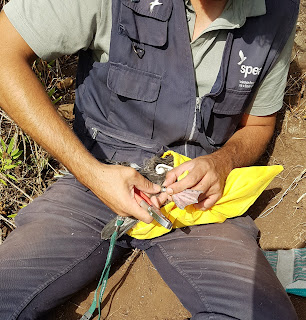Este mês marca o regresso da campanha "Salve uma ave marinha". Esta campanha tem sido lançada todos os anos desde 2009 pela SPEA entre outubro e novembro para sensibilizar o público e várias entidades sobre o problema da poluição luminosa e como esta afecta as aves marinhas. De facto, este período é particularmente crítico para uma espécie de ave marinha, a cagarra.
Entre 15 de outubro e 15 de novembro, os juvenis de cagarras deixam os seus ninhos para iniciar a sua viagem para o mar. É durante esta saída que os juvenis de cagarra tendem a ser atraídos pela iluminação artificial e, desorientados, caem nas nossas cidades, colidem com edifícios, linhas eléctricas e veículos e podendo ficar feridos. São também susceptíveis de serem atropelados por carros e predados por outros animais como cães e gatos. Como não conseguem regressar ao mar sozinhos, precisam da nossa ajuda.
Este ano, a campanha decorrerá de 23 de Outubro a 5 de Novembro (Época crítica). Esta campanha reunirá novamente um grande número de voluntários do arquipélago, mas também do continente e de outros países vizinhos. As patrulhas voluntárias serão efetuadas ao longo de vários municípios para encontrar o maior número de aves desorientadas e libertá-las de volta para o mar. As patrulhas terão lugar na área este da ilha da Madeira, de Câmara de Lobos a Santana, municípios abrangidos pelo projecto LIFE Natura@night. A recolha das aves marinhas desorientadas será também uma oportunidade para efetuar medições biométricas (peso, comprimento da asa e do bico) mas também para colocar dispositivos GPS e alinhá-los. Toda esta informação permitir-nos-á monitorizar os vários indivíduos ao longo do tempo. A instalação do GPS permitir-nos-á aprender mais sobre o comportamento das aves libertadas no mar e qual a sua interação com a costa.
Todos os anos, cerca de 200 aves marinhas, na sua maioria juvenis, são resgatadas.
.png)
Número de aves salvas por município desde 2003 até 2016.
Se tiver interesse em participar na campanha, não é demasiado tarde. Pode inscrever-se como voluntário nas nossas rondas nocturnas de aves em https://forms.gle/boq63qXAuA645y9X8.
Saiba mais em www.naturaatnight.spea.pt
This month marks the return of the ''Campanha Salve uma Ave Marinha'' (Seabird Rescue Campaign). This campaign has been launched every year since 2009 by SPEA between October and November to raise awareness of light pollution and how it affects seabirds. Indeed, this period is particularly critical for one seabird species, Cory's Shearwater.
Between the 15th of October and the 15th of November, the juvenile Cory’s Shearwater leave their nest and start their journey to the sea. At this time, juveniles tend to be attracted to artificial lighting and, disoriented and dazzled, they fall into our cities, collide with buildings, power lines and vehicles and can be injured. They are also susceptible to being run over by cars and being preyed on by other animals such as dogs and cats. As they cannot return to the sea on their own, they need our help.
This year the campaign will run from the 23rd of October to the 5th of November (critical season). This campaign will once again bring together a large number of volunteers from the archipelago but also from the mainland and other neighboring countries. Patrols of volunteers will circulate in the cities to find the disoriented birds and release them back into the sea. The patrols will take place in the east, from Câmara de Lobos to Santana, municipalities covered by the LIFE Natura@night project. The capture of the seabirds will also be an opportunity to carry out biometric measurements (weight, wing and beak length), to place GPS devices and to ring them. All of this information will allow us to monitor the individuals over time. The installation of GPS will allow us to learn more about the behavior of the seabirds released at sea and their interaction with shore.
Every year about 200 seabirds, mostly juveniles, are rescued from light pollution.
Number of birds rescued by municipality from 2003 to 2016.
If you are interested in participating in the campaign, it is not too late. You can sign up to volunteer with us on our night bird rounds at https://forms.gle/boq63qXAuA645y9X8.
Read more on www.naturaatnight.spea.pt


